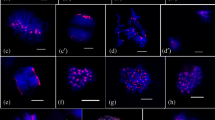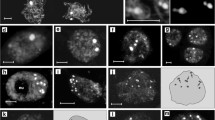Abstract
Differences are demonstrated between A (transcriptionally active) and B (transcriptionally inactive) chromosomes that are characterized by a different level of histone H4 acetylation and a different timing of DNA replication. These differences between the chromatin of A and B chromosomes were found after immunolabelling of chromsomes of Brachycome dichromosomatica with antibodies specific for different acetylated forms (lysine 5, 8, 12 and 16) of histone H4. In contrast to the A chromosomes, which are labelled brightly in their entirety, the transcriptionally inactive B chromosomes are faintly labelled with antibodies against H4Ac5 and H4Ac8. No such difference between the chromosomes is found after immunostaining with the other antibodies H4Ac12 and H4Ac16. Analysis of DNA replication timing in root-tip meristems suggests that B chromosomes are labelled late in S-phase compared with A chromosomes. After C-banding the B chromosome appeared to have a similar amount of heterochromatin to the A chromosomes.
Similar content being viewed by others
References
Abraham S, Ames IH, Smith HH (1968) Autoradiographic studies of DNA synthesis in the B chromosomes of Crepis capillaris. Heredity 59: 297-299.
Attisano L, Newis PN (1990) Purification and characterization of the porcine liver nuclear histone acetyltransferase. J Biol Chem 265: 3949-3955.
Belyaev ND, Keohane AM, Turner BM (1996a) Histone H4 acetylation and replication timing in Chinese hamster chromosomes. Exp Cell Res 225: 277-285.
Belyaev ND, Keohane AM, Turner BM (1996b) Differential underacetylation of histones H2A, H3 and H4 on the inactive X chromosome in human female cells. Hum Genet 97: 573-378.
Bennett ST, Leitch IJ, Bennett MD (1995) Chromosome identification and mapping in the grass Zingeria biebersteiniana (2n = 4) using fluorochromes. Chrom Res 3: 101-108.
Braunstein M, Rose AB, Holmes SG, Allis CD, Broach JR (1993) Transcriptional silencing in yeast is associated with reduced nucleosome acetylation. Genes Dev 7: 592-604.
Cano MI, Santos JL (1988) B chromosomes of the grasshopper Heteracris littoralis: meiotic behaviour and endophenotypic effects in both sexes. Genome 30: 797-801.
Carter CR (1978) The cytology of Brachycome. 8. The inheritance, frequency and distribution of B chromosomes on B. dichromosomatica (n = 2), formerly included in B. lineariloba. Chromosoma 67: 109-121.
Donald TM, Leach CR, Clough A, Timmis JN (1995) Ribosomal RNA genes and the B chromosome of Brachycome dichromosomatica. Heredity 74: 556-561.
Donald TM, Houben A, Leach CR, Timmis JN (1997) Ribosomal RNA genes specific to the B chromosomes in Brachycome dichromosomatica are not transcribed. Genome (in press).
Dover GA, Riley R (1972) The prevention of pairing of homeologous meiotic chromosomes of wheat by a genetic activity of supernumerary chromosomes of Aegilops. Nature 240: 159-161.
Felsenfeld G (1992) Chromatin as an essential part of the transcriptional mechanism. Nature 355: 219-224.
Green DM (1990) Muller's ratchet and the evolution of supernumerary chromosomes. Genome 33: 818-824.
Greilhuber J, Septa F (1976) C-banded karyotypes in the Scale hohenackeri group, S. persica, and Puschkinia (Liliaceae). Plant System Evol 126: 149-188.
Hackstein JHP, Hochstenbach R, Hauschtek-Jungen E, Beukeboom WL (1996) Is the Y chromosome of Drosophila an evolved supernumerary chromosome? BioEssays 18: 317-323.
Houben A, Belyaev ND, Turner BM, Schubert I (1996) Differential immunostaining of plant chromosomes by antibodies recognizing acetylated histone H4 variants. Chrom Res 4: 191-194.
Idei S, Kondon K, Turner BM, Fukui K (1996) Tomographic distribution of acetylated histone H4 in plant chromosomes, nuclei and nucleoli. Chromosoma 105: 293-302.
Jeppesen P, Turner BM (1993) The inactive X chromosome in female mammals is distinguished by a lack of histone H4 acetylation, a cytogenetic marker for gene expression. Cell 74: 281-289.
Jones RN (1995) Tansley Review No. 85. B chromosomes in plants. New Phytol 103: 411-434.
Loidl P (1988) Towards an understanding of the biological function of histone acetylation. FEBS Lett 227: 91-95.
Loidl P (1994) Histone acetylation: facts and questions. Chromosoma 103: 441-449.
Lopez-Rodas G, Georgieva EI, Sendra R, Loidl, P (1991) Histone acetylation in Zea mays 1. J Biol Chem 266: 18745-18750.
Matthews HR (1988) Histone modifications and chromatin structure. In: Adolph K, ed. Chromosomes and Chromatin 1. Boca Raton: CRC Press, pp 3-32.
O'Neill LP, Turner BM (1995) Histone H4 acetylation distinguishes coding regions of the human genome from heterochromatin in a differentiation-dependent by transcriptions-independent manner. EMBO J 14: 3946-3957.
Plowman AB, Bougourd SM (1994) Selectively advantageous effects of B chromosomes on germination behaviour in Allium scheonoprasum L. Heredity 72: 589-593.
Roth SY, Allis, CD (1996) Histone acetylation and chromatin assembly: a single escort, multiple dances? Cell 87: 5-8.
Siroky J, Janousek B, Mouras A, Vyskot B (1994) Replication patterns of sex chromosomes in Melandrium album female cells. Hereditas 120: 175-181.
Takagi M, Sugawara O, Sasaki M (1982) Regional and temporal changes in the pattern of X-chromosome replication during the early postimplantation of the female mouse. Chromosoma 85: 275-286.
Turner BM (1989) Acetylation and deacetylation of histone H4 continue through metaphase with depletion of more-acetylated isoforms and altered site usage. Exp Cell Res 182: 206-214.
Turner BM (1993) Decoding the nucleosome. Cell 75: 5-8.
Turner BM, Fellows G (1989) Specific antibodies reveal ordered and cell-cycle-related use of histone-H4 acetylation sites in mammalian cells. Eur J Biochem 179: 131-139.
Watanabe K, Carter CR, Smith-White S (1975) The cytology of Brachycome lineariloba. 5. Chromosome relationships and phylogeny of the race A cytodemes (n = 2). Chromosoma 52: 383-397.
Webb GC, Neuhaus P (1979) Chromosome organisation in the Australian plague locust Chortoicetes terminifera. 2. Banding variants of the B-chromosome. Chromosoma 70: 205-238.
Author information
Authors and Affiliations
Rights and permissions
About this article
Cite this article
Houben, A., Belyaev, N.D., Leach, C.R. et al. Differences of histone H4 acetylation and replication timing between A and B chromosomes of Brachycome dichromosomatica. Chromosome Res 5, 233–237 (1997). https://doi.org/10.1023/B:CHRO.0000032297.10876.86
Issue Date:
DOI: https://doi.org/10.1023/B:CHRO.0000032297.10876.86




